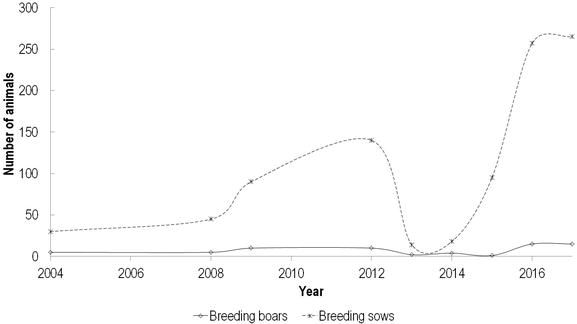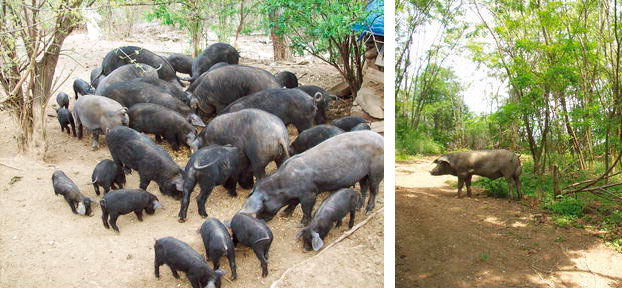History and current status of the breed
Šiška, a primitive breed of pigs created by domestication of wild pigs, was of great importance in the eighteenth century for the development of pig farming in the territory of Serbia, Croatia, Slovenia, Hungary, Romania, and Bulgaria. In the nineteenth century, in better conditions of rearing, from Šiška the Šumadinka breed of pig was created. Unfortunately, both breeds had disappeared permanently today. However, Moravka a breed of combined production traits was created as a result of unsystematic crossings of Šumadinka and Berkshire. In order to create herds of pigs for pure breeding, and partly to improve the production characteristics of domestic breed Šumadinka, at the end of nineteenth and beginning of twentieth century, the breeds Berkshire and Yorkshire have been imported. This is why Moravka is also known by the name “Moravka Black English”. In 1909 there was a proposal that Black English pigs called “Moravka” should be bred in a pure breed with better care, nutrition and selection, but also crossing with Yorkshire was proposed, with the selection control of cross pigs. However, there is no relevant information whether this crossing was done. In addition to Moravka, at the same time, Resavka breed (“Colourful Moravka”) was created in a similar way but in smaller numbers. The only difference is the colour, since Resavka has unequal fields of black and white-yellowish colour of the hair and skin. Chronological distribution of Moravka pig breed is presented in Figure 1. Presently, in Serbia there are only 25 registered farms with 265 breeding sows and 15 boars of Moravka pig breed in the latest available status (February 2018).


Exterior phenotypic characteristics
Information about the morphological characteristics of Moravka pig is summarized in Table 1. The Moravka pig has relatively thin, pigmented black skin and thick but rare (“naked Moravka”) black hair, which is smooth and straight. The longer hairs are located on the ridge, neck, and upper parts and thinner on the lower parts of the body. When removing hair from the skin with hot water, the pigmented epidermis is removed, after which the skin that is completely white remains. The neck is of medium length and is often narrow. The body is quite long and often narrow, and the back line is slightly convex or straight. The extremities are medium long, thin, gentle, and poorly covered with muscle tissue (Figures 2). When the animals are reared in the intensive conditions, they have well-defined exterior widths. The mammary complex consists of four to six pairs of teats.
Table 1. Summary of the main morphological characteristics of the Moravka pig breed.
| Measurement (average) | Adult male | Adult female |
|---|---|---|
| Body weight (kg) | 98.0 | 93.7 |
| Body length1(cm) | 84.6 | 82.6 |
| Height at withers (cm) | 63.4 | 62.4 |
| Number of teats (average) | - | 8-12 |
1Measured from the tip of the nose to the starting point of the tail.

Geographical location and production system
Moravka pig breed was first developed in extensive management conditions in the Morava Valley of central Serbia. In the present times, Moravka pigs are reared in municipalities of Despotovac, Ub, Ljig, Mionica, Mladenovac, Topola, Prokuplje, and Kuršumlija. These pigs are usually reared in free-range conditions and outdoor extensive or semi-intensive systems. Rearing of pigs implies a free holding in the limited areas in pastures, woods, or orchards. In extensive system, pigs are kept around the house, which depends on the number of animals and size of the owner’s household, and in the winter period, animals are housed in cheap, wooden pig stables. Feeding is primarily based on pasture and forest products (oaks, wild fruits). Additional daily meal represents an extremely small amount of grains per head, primarily corn. In extensive system sows very frequently farrow in the forest, which significantly complicates the control of productivity and record keeping. In semi-intensive conditions, sows farrow in objects, which enable better control. In the growing and fattening phase, pigs are mostly in the open section. They are rarely intensely fattened; however if so they achieve a satisfactory growth rate.
Productive performance
Reproductive traits
The age of sows at first parturition is approximately 11.6 months. Sows of Moravka pig breed have 1.5 litters per year. Average piglet birth weight is 1.3 kg. Stillborn percentage of piglets and mortality rate until weaning are not reported within considered studies. Duration of lactation is prolonged in comparison to modern intensive systems to 60 days, which leads to a longer farrowing interval (243 days) and higher weaning weight (10 kg).
Growth performance
Due to big differences between studies with regard to the live weight range covered, we defined the stages for growth performance as growing stage (from weaning to approximately 30 kg live body weight) and early, middle, and late fattening stages estimated between approximately 30 and 60 kg, 60 and 100 kg, and above 100 kg live body weight, respectively. Sometimes the source provided only the overall growth rate for the whole fattening stage (defined as overall) or even from birth to slaughter (defined as birth–slaughter, which is often calculated from the data given on live weight and age of pigs). It should also be noted that a big part of the collected studies simulated practical conditions of the production systems used and that only a smaller part of the studies actually aimed at evaluating the breed growth potential. In the considered studies, an average daily gain in growing stage was extremely low (192 g/day) and increased to 477, 521, and 478 g/day in early, middle, and late fattening stages. The average daily gain in the overall fattening stage was 508 g/day and only 285 g/day in the period from birth to slaughter. In the context of the evaluation of growth performance, it is also of interest to observe the extreme values, because it can be assumed that the maximum figures exhibit the growth potentials of Moravka pigs in ad libitum conditions of feeding (≈660 g/day in overall fattening stage). The maximal growth rate with completed feed mixture observed for Moravka was 607 g in the period corresponding to average body weight of 79 and 89 kg.
In considered studies, the information on feed intake and feed nutritional value were scarce, which limits the evaluation of growth potential. Average daily feed intake increased from 1.8 kg/day in the early fattening stage to 3.0 kg/day in the late fattening stage, whereas pigs consumed 1.4–2.6 kg/day considering overall fattening period.

Body composition and carcass traits
Basic data obtained in this review with some of the most commonly encountered carcass traits that could be compared are presented in Table 6. In considered studies, pigs of the Moravka breed were slaughtered at an approximately 133 kg live weight. Dressing yield was between 76 and 83% and lean meat content between 32 and 39% (SEUROP classification or dissection). The backfat thickness values measured at the level of the last rib ranged from 35 to 84 mm, at the position of withers from 59 to 94 mm, and at the level of the gluteus medius muscle from 42 to 83 mm. Muscularity measured as loin eye area averaged 27 cm2 and as muscle thickness above the gluteus medius 63 mm.
Meat quality
In the studies reporting meat quality of Moravka pigs, the traits considered were pH measured in the longissimus muscle at 45 min and 24 h post-mortem that were 6.0–6.5 and 5.7–5.9, respectively. The intramuscular fat content was 6.7%, and colour measured in CIE L*, a*, b* colour space was around 52, 10.2, and 5.3 for L*, a*, and b*. In available studies SFA, MUFA, and PUFA content of intramuscular fat in the longissimus muscle were approximately 42, 54, and 4%, respectively. The research of Savić et al. showed that castrated males exhibited higher content of saturated fatty acids C14:0 and C18:0 than females. Increase of slaughter weight was accompanied with decrease of linoleic acid, decrease of total content of polyunsaturated acids, increase of palmitoleic acid, increase in total content of monounsaturated fatty acids, increase of C17:0, and decreased of P/S ratio.
Use of breed and main products
The potential of the Moravka breed is untapped. The territory of Serbia has high potential of rearing autochthonous breeds, given the natural resources it possesses. The autochthonous Moravka breed is well adapted to this area, so it is one of the breeds that are suitable for outdoor rearing, in an ecological or organic, low-input production system. The study of Radović et al. showed not significant better growth rate between Moravka and Moravka x Duroc (average daily gain, 368.9 vs. 503.0 g) but higher content of meat in carcass sides (35.2 vs. 43.6%). The animals not included in the nucleus herd could be crossed with Duroc, which would contribute to more economical production of meat. From this crossbreed, with combined production capabilities, we could obtain quality raw materials for the production of various products (ham, dried bacon, sausages). Today, on individual farms, these products are made according to traditional recipes and have added value, and the price of such products is significantly higher than those of conventional products. According to the results of Parunović et al., it is possible to produce some meat products (kulen and sremska dry fermented sausages), with the appropriate combination of meat and fat from local pig breeds, with a respectable chemical content, with a favourable and reasonably healthful fatty acid composition, and with sensory qualities acceptable for consumers. This result should contribute to encouraging the sustainable breeding of the Moravka pigs which can significantly contribute to regional rural development.
Full text and references are available here: Moravka Pig
Radomir Savić, Čedomir Radović, Milica Petrović, Marija Gogić, Dragan Radojković and Nina Batorek-Lukač (February 6th 2019). Moravka Pig, European Local Pig Breeds - Diversity and Performance. A study of project TREASURE, Marjeta Candek-Potokar and Rosa M. Nieto Linan, IntechOpen, DOI: 10.5772/intechopen.83777. Available from: https://www.intechopen.com/books/european-local-pig-breeds-diversity-and-performance-a-study-of-project-treasure/moravka-pig



